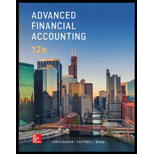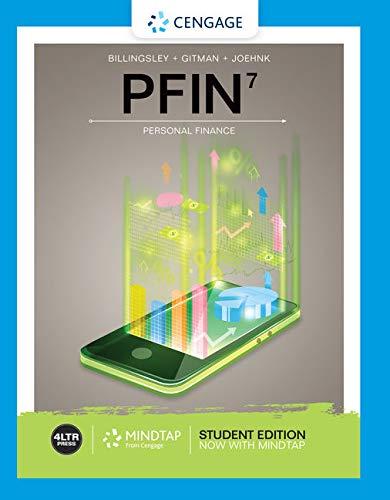
Advanced Financial Accounting
12th Edition
ISBN: 9781259916977
Author: Christensen, Theodore E., COTTRELL, David M., Budd, Cassy
Publisher: Mcgraw-hill Education,
expand_more
expand_more
format_list_bulleted
Question
Chapter 19, Problem 19.18P
To determine
Introduction: The statement of changes in net assets is the equivalent of an income statement of a commercial organization. The change in net assets in the statement is the equivalent of the net profit figure on the income statement. A positive change in the net assets indicate that the non- profit organization is making optimum use of its resources.
To match: The numbered items on the left with the effects of the transactions on the statement of changes in net assets
Given info:various transactions and their effects on the statement of change in net assets is given.
Expert Solution & Answer
Want to see the full answer?
Check out a sample textbook solution
Students have asked these similar questions
Please explain the correct approach for solving this general accounting question.
I am trying to find the accurate solution to this financial accounting problem with appropriate explanations.
I need help finding the correct solution to this financial accounting problem with valid methods.
Chapter 19 Solutions
Advanced Financial Accounting
Ch. 19 - Prob. 19.1QCh. 19 - Prob. 19.2QCh. 19 - Prob. 19.3QCh. 19 - Prob. 19.4QCh. 19 - Prob. 19.5QCh. 19 - Prob. 19.6QCh. 19 - Prob. 19.7QCh. 19 - Prob. 19.8QCh. 19 - Prob. 19.9QCh. 19 - Prob. 19.10Q
Ch. 19 - Prob. 19.11QCh. 19 - Prob. 19.12QCh. 19 - Prob. 19.13QCh. 19 - Prob. 19.14QCh. 19 - Prob. 19.15QCh. 19 - Prob. 19.16QCh. 19 - Prob. 19.17QCh. 19 - Prob. 19.18QCh. 19 - Should a rotary club, an ONPO, report depreciation...Ch. 19 - Prob. 19.20QCh. 19 - Prob. 19.1CCh. 19 - Prob. 19.2CCh. 19 - Prob. 19.3CCh. 19 - Prob. 19.4CCh. 19 - Prob. 19.5CCh. 19 - Prob. 19.7CCh. 19 - Prob. 19.1.1ECh. 19 - Prob. 19.1.2ECh. 19 - Prob. 19.1.3ECh. 19 - Prob. 19.1.4ECh. 19 - Prob. 19.1.5ECh. 19 - Prob. 19.1.6ECh. 19 - Prob. 19.2.1ECh. 19 - Prob. 19.2.2ECh. 19 - Prob. 19.2.3ECh. 19 - Prob. 19.2.4ECh. 19 - Prob. 19.2.5ECh. 19 - Prob. 19.2.6ECh. 19 - Prob. 19.2.7ECh. 19 - Prob. 19.2.8ECh. 19 - Prob. 19.2.9ECh. 19 - Prob. 19.2.10ECh. 19 - Prob. 19.2.11ECh. 19 - Prob. 19.2.12ECh. 19 - Prob. 19.3ECh. 19 - Prob. 19.4ECh. 19 - Prob. 19.5.1ECh. 19 - Prob. 19.5.2ECh. 19 - Prob. 19.5.3ECh. 19 - Prob. 19.5.4ECh. 19 - Prob. 19.5.5ECh. 19 - Prob. 19.5.6ECh. 19 - Prob. 19.5.7ECh. 19 - Prob. 19.5.8ECh. 19 - Prob. 19.5.9ECh. 19 - Prob. 19.6ECh. 19 - Prob. 19.7ECh. 19 - Prob. 19.8.1ECh. 19 - Prob. 19.8.2ECh. 19 - Prob. 19.8.3ECh. 19 - Prob. 19.8.4ECh. 19 - Prob. 19.8.5ECh. 19 - Prob. 19.8.6ECh. 19 - Prob. 19.8.7ECh. 19 - Prob. 19.8.8ECh. 19 - Prob. 19.8.9ECh. 19 - Prob. 19.8.10ECh. 19 - Prob. 19.9ECh. 19 - Prob. 19.10PCh. 19 - Prob. 19.11PCh. 19 - Prob. 19.12PCh. 19 - Prob. 19.13PCh. 19 - Prob. 19.14PCh. 19 - Prob. 19.15PCh. 19 - Prob. 19.16PCh. 19 - Prob. 19.17PCh. 19 - Prob. 19.18PCh. 19 - Prob. 19.19PCh. 19 - Prob. 19.20PCh. 19 - Prob. 19.21PCh. 19 - Prob. 19.22PCh. 19 - Prob. 19.23PCh. 19 - Prob. 19.24.1PCh. 19 - Prob. 19.24.2PCh. 19 - Prob. 19.24.3PCh. 19 - Prob. 19.24.4PCh. 19 - Prob. 19.24.5PCh. 19 - Prob. 19.24.6PCh. 19 - Prob. 19.24.7PCh. 19 - Prob. 19.24.8PCh. 19 - Prob. 19.24.9PCh. 19 - Prob. 19.24.10PCh. 19 - Prob. 19.24.11PCh. 19 - Prob. 19.24.12PCh. 19 - Prob. 19.24.13PCh. 19 - Prob. 19.24.14PCh. 19 - Prob. 19.24.15PCh. 19 - Prob. 19.24.16PCh. 19 - Prob. 19.24.17PCh. 19 - Prob. 19.24.18PCh. 19 - Prob. 19.24.19PCh. 19 - Prob. 19.24.20PCh. 19 - Prob. 19.25PCh. 19 - Prob. 19.26P
Knowledge Booster
Similar questions
- Can you help me solve this general accounting problem with the correct methodology?arrow_forwardI need help with this financial accounting problem using proper accounting guidelines.arrow_forwardPlease provide the solution to this general accounting question using proper accounting principles.arrow_forward
- I need help finding the accurate solution to this general accounting problem with valid methods.arrow_forwardWhen incorporating his sole proprietorship, Joe transfers all of its assets and liabilities. Included in the $30,000 of liabilities assumed by the corporation is $500 that relates to a personal expenditure. Under these circumstances, the entire $30,000 will be treated as boot. / Provide explanation please a. True b. Falsearrow_forwardIn determining whether § 357(c) applies, assess whether the liabilities involved exceed the bases of all assets a shareholder transfers to the corporation./ Provide explanation please. a. True b. Falsearrow_forward
- The ending inventory isarrow_forwardhelparrow_forwardBansai, age 66, retires and receives a $1,450 per month annuity from his employer's qualified pension plan. Bansai made $87,600 of after-tax contributions to the plan before retirement. Under the simplified method, Bansai's number of anticipated payments is 240. What is the amount includible in income in the first year of withdrawals assuming 12 monthly payments? A. $10,560 B. $12,540 C. $17,400 D. $8,220arrow_forward
arrow_back_ios
SEE MORE QUESTIONS
arrow_forward_ios
Recommended textbooks for you
 Pfin (with Mindtap, 1 Term Printed Access Card) (...FinanceISBN:9780357033609Author:Randall Billingsley, Lawrence J. Gitman, Michael D. JoehnkPublisher:Cengage Learning
Pfin (with Mindtap, 1 Term Printed Access Card) (...FinanceISBN:9780357033609Author:Randall Billingsley, Lawrence J. Gitman, Michael D. JoehnkPublisher:Cengage Learning

Pfin (with Mindtap, 1 Term Printed Access Card) (...
Finance
ISBN:9780357033609
Author:Randall Billingsley, Lawrence J. Gitman, Michael D. Joehnk
Publisher:Cengage Learning
